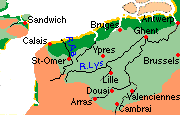Medieval
Cloth Trade
in Flanders & Artois

|
Best
quality wool from England The 'Staple' - export tax
on wool Line of sand dunes
after 9th century Marshes at or below
sea-level, gradually reclaimed low land higher
land MAP:
Flemish towns & the medieval wool
trade |
||||||||||||
|
Trade by
water At Lille there were rapids where all the cargoes had to be off-loaded and carried on horseback along a short road to calmer waters upstream. At Douai boats had to wait to pass through a lock on the river - and pay another tax. Boats could supply cloth towns as far from the sea as St-Omer, Bethune, and Arras with their raw materials, and then take away their goods to distant markets. |
Medieval Bethune - boats came up the river Lys from the Flemish coastal ports. |
|||||||||||
|
Cloth
merchants European
Trade |
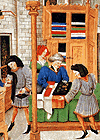 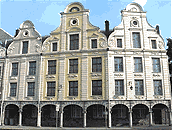 (left) 15th century cloth merchants. (right) Arras cloth merchants houses are preserved in the famous market squares.
cloth Hall -Ypres??? Bruges??? |
|||||||||||
|
Royal patronage - 'Golden
Age' |
||||||||||||
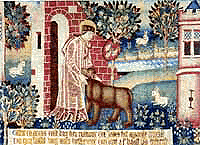 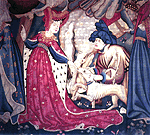 1. A rare surviving tapestry from Arras: "St.Vaast and the bear" 2. A 14th century Flemish tapestry shows the sorts of fine cloth they produced which became fashionable throughout Europe. |
||||||||||||
|
1337-1453
Effects of wars with
England Meanwhile cloth production flourished in
Flanders, sheltered by the power of first the Dukes of
Burgundy, and then the Spanish Empire (see 'History
of Flanders'). Artois
in the south was caught between France and Flanders, and
came off worst. |
 1491 Tourcoing was granted the right to hold an annual tax-free "Franche Foire" by Maximilien of Austria - a big boost for the local textile trade (picture is present-day version!). |
|||||||||||
|
Lille's Exchange 1652 |
||||||||||||
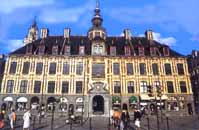  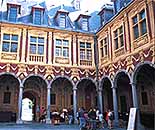 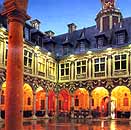 1652: Lille, Vieille Bourse: King Philip II of Spain granted Lille this new Exchange, on the lines of those that had been so successful in Antwerp and other Dutch towns. 24 cloth merchants each had a shop/offices around the courtyard, to buy and sell their wares to foreign buyers and traders, and arrange finance. Magnificent building recently restored; courtyard open day and evening. |
||||||||||||
|
18th century - End of the
'Golden Age' The Flemish cloth towns also faced competition from rural weavers, who - away from the controls of the town guilds - made poorer quality but cheaper cloth that required less skill, and found a ready market with the middle classes.Back to top |
||||||||||||
|
Background
information |
Places to
visit |
|
|
Follow these links to trace the development of the North's textile industries |
|
|
|
|
|
|
